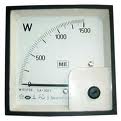Work and power of electric current
 Electric current passing through wires works by turning electrical energy into any other energy: heat, light, mechanical, chemical, etc. For more details see here: Action of electric current
Electric current passing through wires works by turning electrical energy into any other energy: heat, light, mechanical, chemical, etc. For more details see here: Action of electric current
If a voltage of one volt is applied to the consumer of electrical energy, it means that the source of electrical energy, transferring one pendant of electricity through the consumer, consumes one joule of electrical energy in it.
Electric current converts this energy into another type of energy, and therefore it is customary to say that the electric current passing through the consumer does work... The amount of this work is equal to the amount of electrical energy consumed by the source.
Power is the value characterizing the speed at which energy conversionor the rate at which work is done.
In the source of EMF under the influence of chemical forces (in primary cells and batteries) or electromagnetic forces in electric generators, separation of charges occurs.
Work done by external forces in the source when the charge moves In or, as it is said, "developed" in the source Electrical energy, is found by the formula:
A = QE
If the source is closed to an external circuit, then charges are continuously being released into it and the external forces are still doing work A = QE, or given that Q = It, A = EIt.
From law of conservation of energy electrical energy generated by an EMF source during the same time is "spent" (ie converted) into other types of energy in the sections of the electrical circuit.
Part of the energy is spent in the outer section:
A1 = UQ = UIt,
where U is the source terminal voltage, which with the external circuit closed is no longer equal to the EMF.
Another part of the energy is "lost" (transformed into heat) inside the source:
A2 = A — A1 = (E — U) It = UoIt
In the last formula, Uo — this is the difference between the EMF and the source terminal voltage, which is called the internal voltage drop… Therefore,
Uo = E — U,
where
E = U + Uo
i.e. The source emf is equal to the sum of the terminal voltage and the internal voltage drop.
An example. The electric kettle is connected to a 220 volt network. It is necessary to determine the energy consumed in the kettle for 12 minutes, if the current in the heating element of the kettle is 2.5 A.
A =220 · 2.5 · 60 = 396000 J.
The value characterizing the rate at which energy is converted or the rate at which work is done is called power (notation P):
P = A / t
The strength of an electric current is its work per unit time.
The value characterizing the rate at which mechanical or other energy is converted into electrical energy in a source is called generator power:
Pr = A / t = EIt / t = EI
 The value characterizing the rate at which the transformation of electrical energy in external sections of the circuit into other types of energy, called consumer power:
The value characterizing the rate at which the transformation of electrical energy in external sections of the circuit into other types of energy, called consumer power:
P1 = A1 / t = UIt / t = UI
The power characterizing the non-productive consumption of electrical energy, for example for heat losses inside the generator, is called power loss:
Po = (A — A1) / t = UoIt / t = UoI
According to the law of conservation of energy, the power of the generator is equal to the sum of the powers; users and losses:
Pr = P1 + Po
Units of work and power
The power unit is found from the formula P = A / t = j / sec. An electric current develops power in one watt if it performs work equal to one joule every second.
The unit of measurement of power j / s is called watt (designation W), i.e. 1 W = 1 j / s.
On the other hand, from A = QE 1 J = 1 Kx l V, whence 1 W = (1V x 1K) / 1s1 = 1V x 1 A = 1 VA, that is, the watt is the power of an electric current in 1 A at a voltage of 1 V .
The larger units of power are the hectowatt 1 GW = 100 W and the kilowatt — 1 kW = 103 W
Electrical energy is usually calculated in: watt-hours (Wh) or multiple units: hectowatt-hours (GWh) and kilowatt-hours (kWh). 1 kilowatt-hour = 3,600,000 joules.
